Business Law Report: Evaluating UK Legal System and Obligations
VerifiedAdded on 2020/07/22
|15
|4343
|37
Report
AI Summary
This report provides a comprehensive overview of UK business law, beginning with an introduction to the English legal system's structure and sources of law, including the roles of government and justice courts. It evaluates the effectiveness of recent legal reforms and developments. The report then delves into employer's legal obligations, covering occupational health and safety, worker's compensation, and harassment, analyzing their impact on businesses through employment and contract law. It presents suggested legal solutions for business problems, supported by case studies and justifications. Finally, the report explains alternative dispute resolution processes, offering recommendations and legal solutions in comparison with alternative legal advice. The report aims to provide a detailed understanding of the legal framework governing businesses in the UK.

BUSINESS LAW
Paraphrase This Document
Need a fresh take? Get an instant paraphrase of this document with our AI Paraphraser
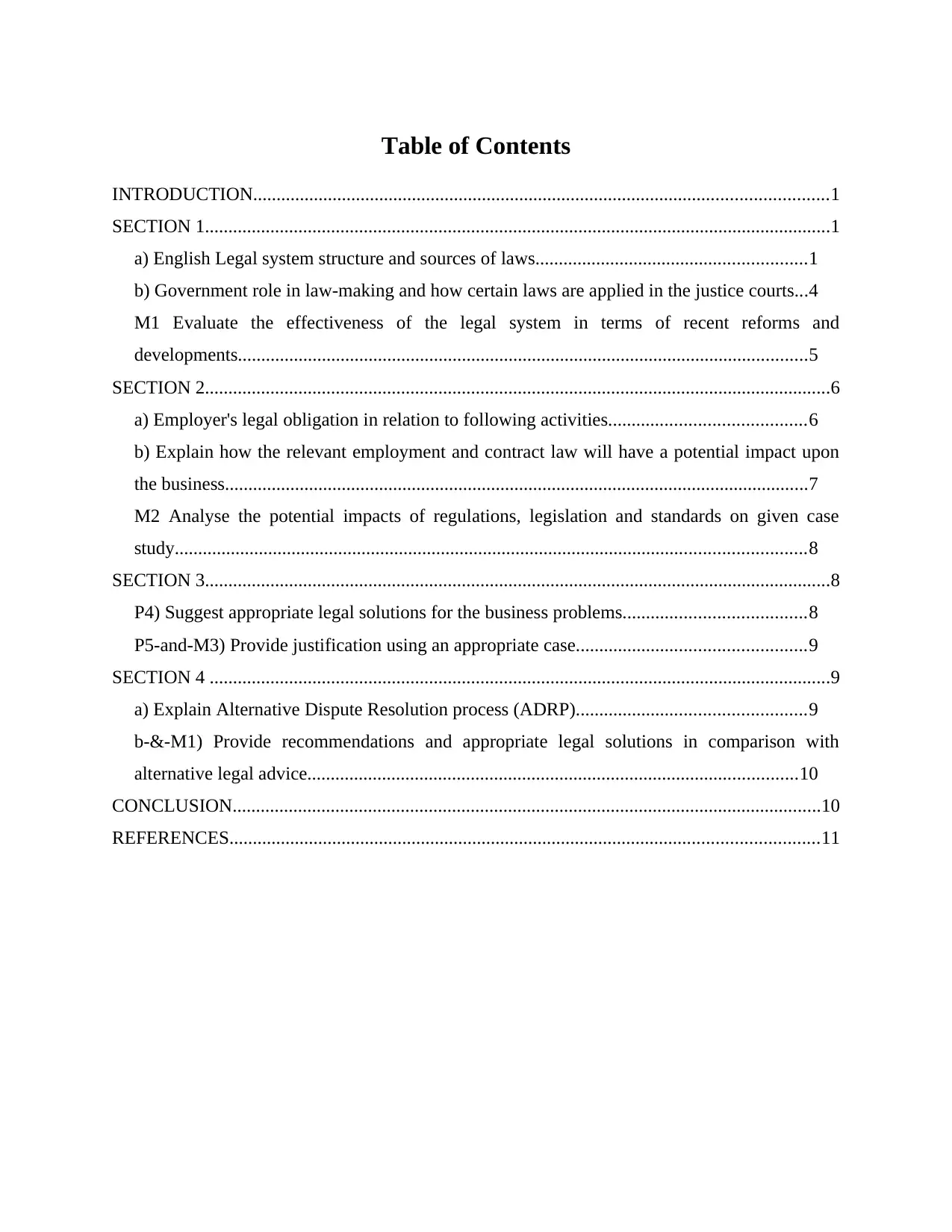
Table of Contents
INTRODUCTION...........................................................................................................................1
SECTION 1......................................................................................................................................1
a) English Legal system structure and sources of laws..........................................................1
b) Government role in law-making and how certain laws are applied in the justice courts...4
M1 Evaluate the effectiveness of the legal system in terms of recent reforms and
developments..........................................................................................................................5
SECTION 2......................................................................................................................................6
a) Employer's legal obligation in relation to following activities..........................................6
b) Explain how the relevant employment and contract law will have a potential impact upon
the business.............................................................................................................................7
M2 Analyse the potential impacts of regulations, legislation and standards on given case
study.......................................................................................................................................8
SECTION 3......................................................................................................................................8
P4) Suggest appropriate legal solutions for the business problems.......................................8
P5-and-M3) Provide justification using an appropriate case.................................................9
SECTION 4 .....................................................................................................................................9
a) Explain Alternative Dispute Resolution process (ADRP).................................................9
b-&-M1) Provide recommendations and appropriate legal solutions in comparison with
alternative legal advice.........................................................................................................10
CONCLUSION..............................................................................................................................10
REFERENCES..............................................................................................................................11
INTRODUCTION...........................................................................................................................1
SECTION 1......................................................................................................................................1
a) English Legal system structure and sources of laws..........................................................1
b) Government role in law-making and how certain laws are applied in the justice courts...4
M1 Evaluate the effectiveness of the legal system in terms of recent reforms and
developments..........................................................................................................................5
SECTION 2......................................................................................................................................6
a) Employer's legal obligation in relation to following activities..........................................6
b) Explain how the relevant employment and contract law will have a potential impact upon
the business.............................................................................................................................7
M2 Analyse the potential impacts of regulations, legislation and standards on given case
study.......................................................................................................................................8
SECTION 3......................................................................................................................................8
P4) Suggest appropriate legal solutions for the business problems.......................................8
P5-and-M3) Provide justification using an appropriate case.................................................9
SECTION 4 .....................................................................................................................................9
a) Explain Alternative Dispute Resolution process (ADRP).................................................9
b-&-M1) Provide recommendations and appropriate legal solutions in comparison with
alternative legal advice.........................................................................................................10
CONCLUSION..............................................................................................................................10
REFERENCES..............................................................................................................................11
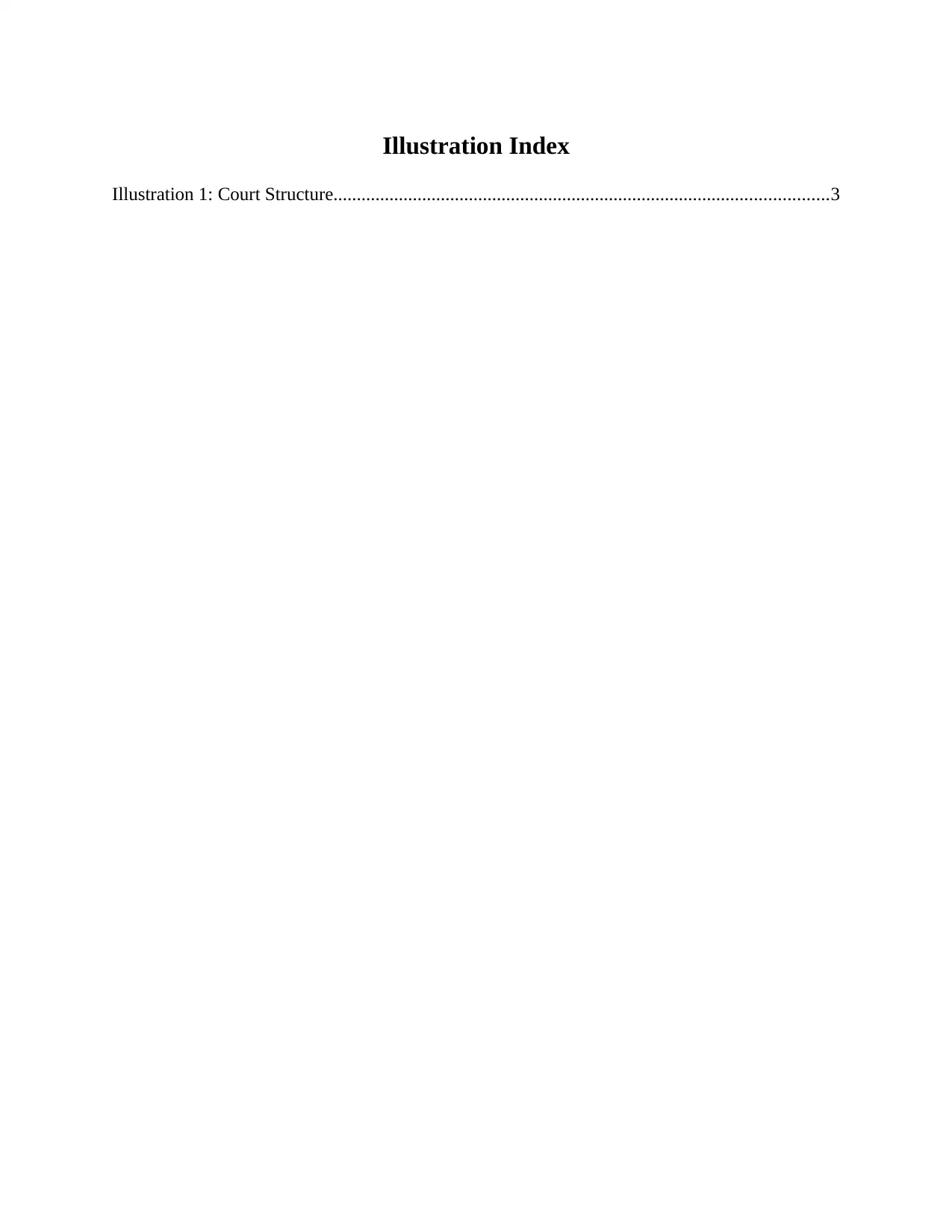
Illustration Index
Illustration 1: Court Structure..........................................................................................................3
Illustration 1: Court Structure..........................................................................................................3
⊘ This is a preview!⊘
Do you want full access?
Subscribe today to unlock all pages.

Trusted by 1+ million students worldwide
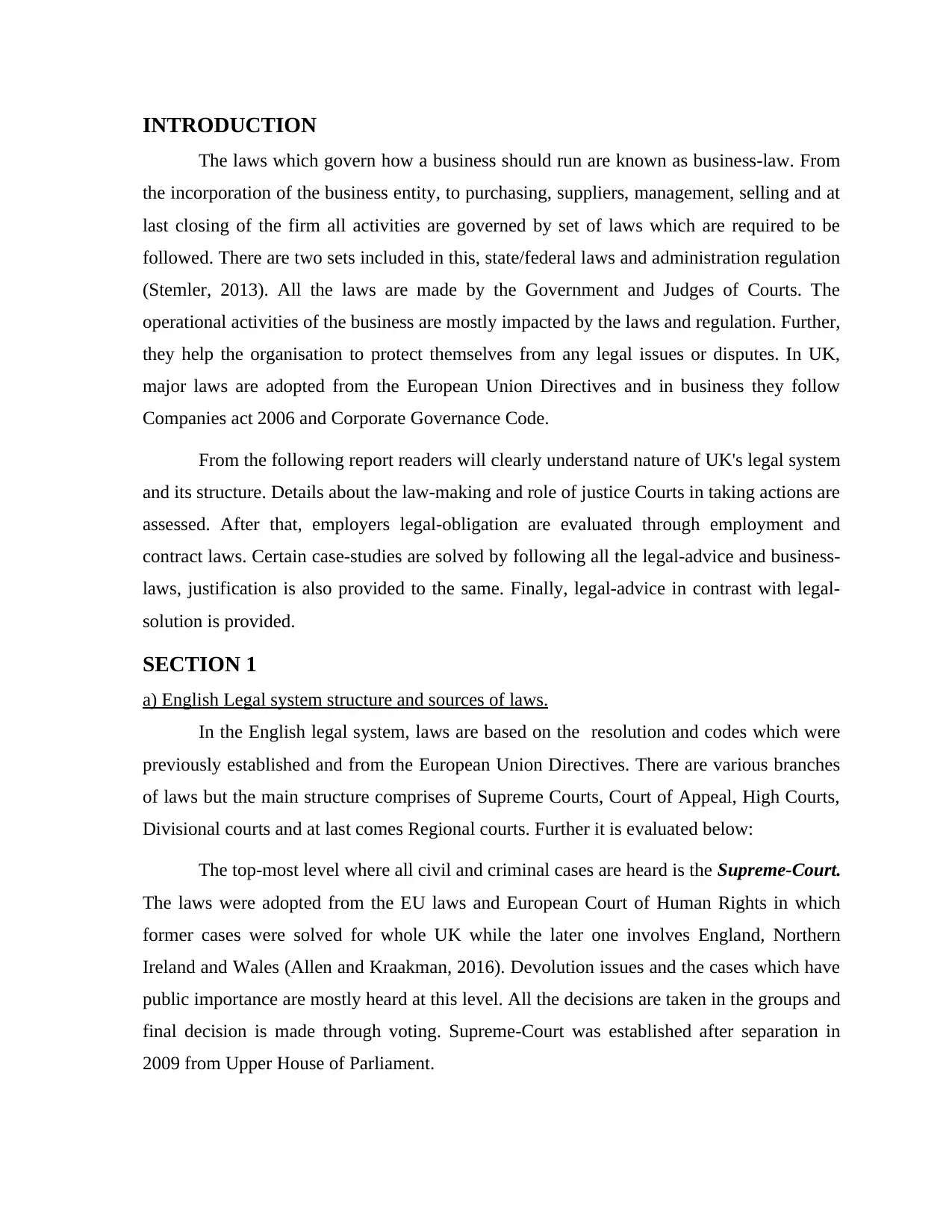
INTRODUCTION
The laws which govern how a business should run are known as business-law. From
the incorporation of the business entity, to purchasing, suppliers, management, selling and at
last closing of the firm all activities are governed by set of laws which are required to be
followed. There are two sets included in this, state/federal laws and administration regulation
(Stemler, 2013). All the laws are made by the Government and Judges of Courts. The
operational activities of the business are mostly impacted by the laws and regulation. Further,
they help the organisation to protect themselves from any legal issues or disputes. In UK,
major laws are adopted from the European Union Directives and in business they follow
Companies act 2006 and Corporate Governance Code.
From the following report readers will clearly understand nature of UK's legal system
and its structure. Details about the law-making and role of justice Courts in taking actions are
assessed. After that, employers legal-obligation are evaluated through employment and
contract laws. Certain case-studies are solved by following all the legal-advice and business-
laws, justification is also provided to the same. Finally, legal-advice in contrast with legal-
solution is provided.
SECTION 1
a) English Legal system structure and sources of laws.
In the English legal system, laws are based on the resolution and codes which were
previously established and from the European Union Directives. There are various branches
of laws but the main structure comprises of Supreme Courts, Court of Appeal, High Courts,
Divisional courts and at last comes Regional courts. Further it is evaluated below:
The top-most level where all civil and criminal cases are heard is the Supreme-Court.
The laws were adopted from the EU laws and European Court of Human Rights in which
former cases were solved for whole UK while the later one involves England, Northern
Ireland and Wales (Allen and Kraakman, 2016). Devolution issues and the cases which have
public importance are mostly heard at this level. All the decisions are taken in the groups and
final decision is made through voting. Supreme-Court was established after separation in
2009 from Upper House of Parliament.
The laws which govern how a business should run are known as business-law. From
the incorporation of the business entity, to purchasing, suppliers, management, selling and at
last closing of the firm all activities are governed by set of laws which are required to be
followed. There are two sets included in this, state/federal laws and administration regulation
(Stemler, 2013). All the laws are made by the Government and Judges of Courts. The
operational activities of the business are mostly impacted by the laws and regulation. Further,
they help the organisation to protect themselves from any legal issues or disputes. In UK,
major laws are adopted from the European Union Directives and in business they follow
Companies act 2006 and Corporate Governance Code.
From the following report readers will clearly understand nature of UK's legal system
and its structure. Details about the law-making and role of justice Courts in taking actions are
assessed. After that, employers legal-obligation are evaluated through employment and
contract laws. Certain case-studies are solved by following all the legal-advice and business-
laws, justification is also provided to the same. Finally, legal-advice in contrast with legal-
solution is provided.
SECTION 1
a) English Legal system structure and sources of laws.
In the English legal system, laws are based on the resolution and codes which were
previously established and from the European Union Directives. There are various branches
of laws but the main structure comprises of Supreme Courts, Court of Appeal, High Courts,
Divisional courts and at last comes Regional courts. Further it is evaluated below:
The top-most level where all civil and criminal cases are heard is the Supreme-Court.
The laws were adopted from the EU laws and European Court of Human Rights in which
former cases were solved for whole UK while the later one involves England, Northern
Ireland and Wales (Allen and Kraakman, 2016). Devolution issues and the cases which have
public importance are mostly heard at this level. All the decisions are taken in the groups and
final decision is made through voting. Supreme-Court was established after separation in
2009 from Upper House of Parliament.
Paraphrase This Document
Need a fresh take? Get an instant paraphrase of this document with our AI Paraphraser
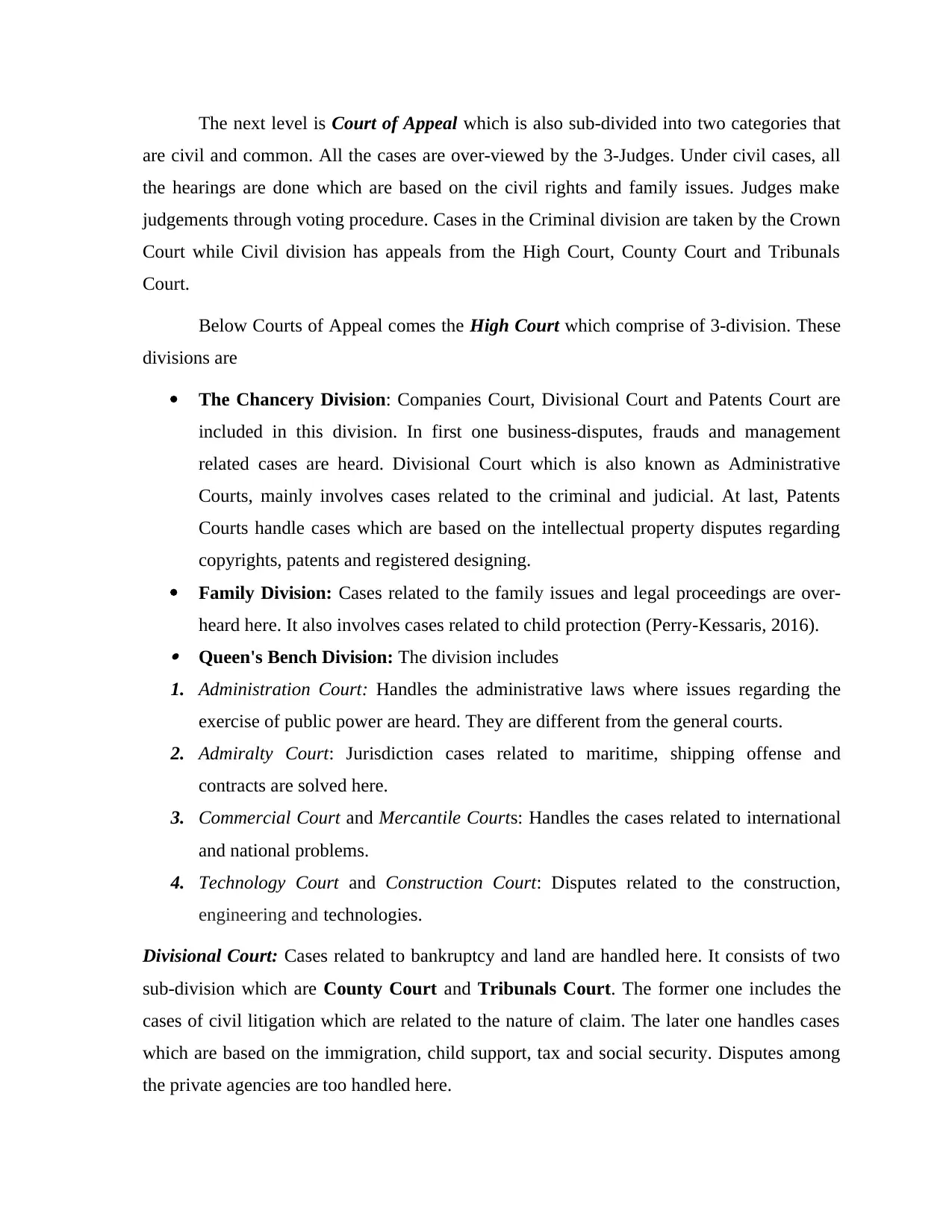
The next level is Court of Appeal which is also sub-divided into two categories that
are civil and common. All the cases are over-viewed by the 3-Judges. Under civil cases, all
the hearings are done which are based on the civil rights and family issues. Judges make
judgements through voting procedure. Cases in the Criminal division are taken by the Crown
Court while Civil division has appeals from the High Court, County Court and Tribunals
Court.
Below Courts of Appeal comes the High Court which comprise of 3-division. These
divisions are
The Chancery Division: Companies Court, Divisional Court and Patents Court are
included in this division. In first one business-disputes, frauds and management
related cases are heard. Divisional Court which is also known as Administrative
Courts, mainly involves cases related to the criminal and judicial. At last, Patents
Courts handle cases which are based on the intellectual property disputes regarding
copyrights, patents and registered designing.
Family Division: Cases related to the family issues and legal proceedings are over-
heard here. It also involves cases related to child protection (Perry-Kessaris, 2016).
Queen's Bench Division: The division includes
1. Administration Court: Handles the administrative laws where issues regarding the
exercise of public power are heard. They are different from the general courts.
2. Admiralty Court: Jurisdiction cases related to maritime, shipping offense and
contracts are solved here.
3. Commercial Court and Mercantile Courts: Handles the cases related to international
and national problems.
4. Technology Court and Construction Court: Disputes related to the construction,
engineering and technologies.
Divisional Court: Cases related to bankruptcy and land are handled here. It consists of two
sub-division which are County Court and Tribunals Court. The former one includes the
cases of civil litigation which are related to the nature of claim. The later one handles cases
which are based on the immigration, child support, tax and social security. Disputes among
the private agencies are too handled here.
are civil and common. All the cases are over-viewed by the 3-Judges. Under civil cases, all
the hearings are done which are based on the civil rights and family issues. Judges make
judgements through voting procedure. Cases in the Criminal division are taken by the Crown
Court while Civil division has appeals from the High Court, County Court and Tribunals
Court.
Below Courts of Appeal comes the High Court which comprise of 3-division. These
divisions are
The Chancery Division: Companies Court, Divisional Court and Patents Court are
included in this division. In first one business-disputes, frauds and management
related cases are heard. Divisional Court which is also known as Administrative
Courts, mainly involves cases related to the criminal and judicial. At last, Patents
Courts handle cases which are based on the intellectual property disputes regarding
copyrights, patents and registered designing.
Family Division: Cases related to the family issues and legal proceedings are over-
heard here. It also involves cases related to child protection (Perry-Kessaris, 2016).
Queen's Bench Division: The division includes
1. Administration Court: Handles the administrative laws where issues regarding the
exercise of public power are heard. They are different from the general courts.
2. Admiralty Court: Jurisdiction cases related to maritime, shipping offense and
contracts are solved here.
3. Commercial Court and Mercantile Courts: Handles the cases related to international
and national problems.
4. Technology Court and Construction Court: Disputes related to the construction,
engineering and technologies.
Divisional Court: Cases related to bankruptcy and land are handled here. It consists of two
sub-division which are County Court and Tribunals Court. The former one includes the
cases of civil litigation which are related to the nature of claim. The later one handles cases
which are based on the immigration, child support, tax and social security. Disputes among
the private agencies are too handled here.
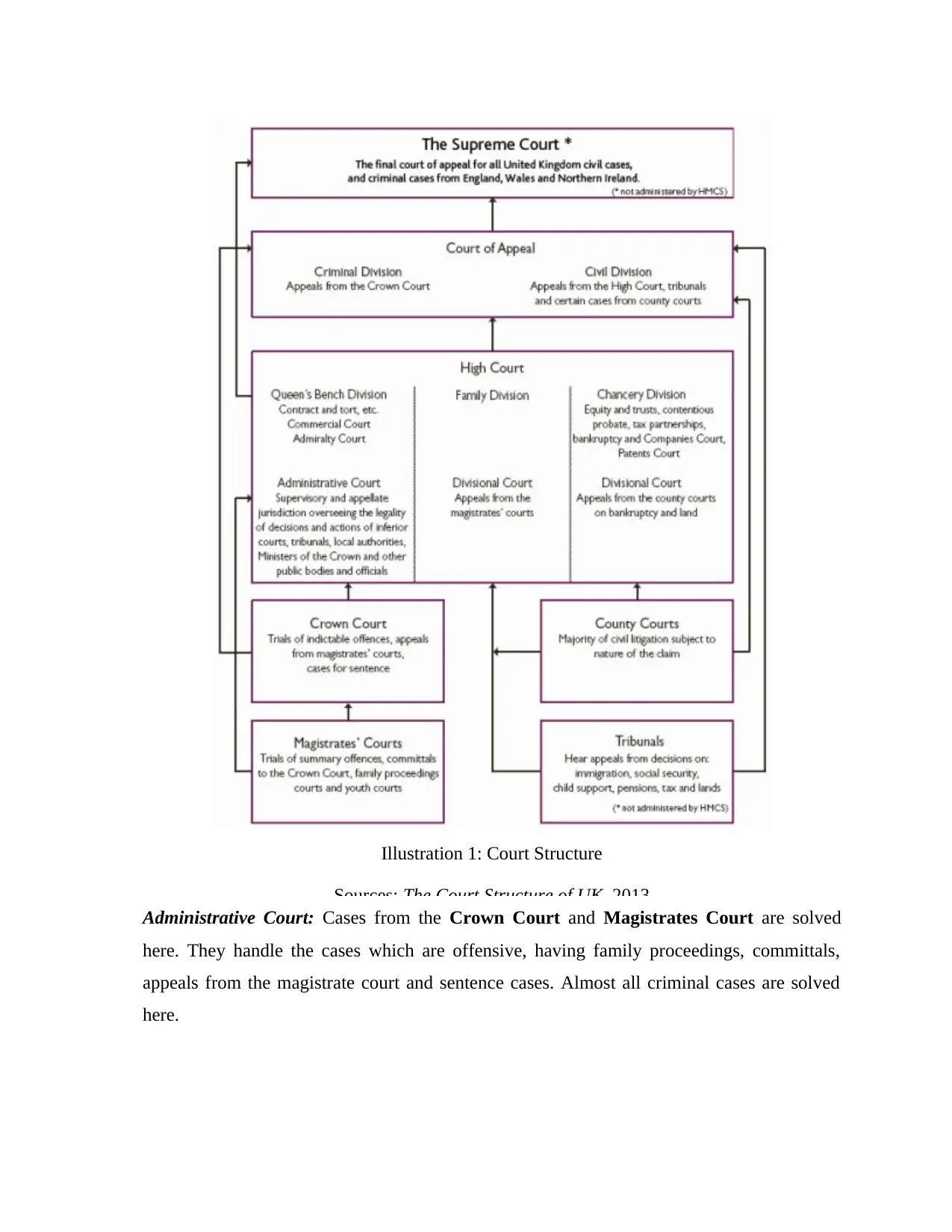
Administrative Court: Cases from the Crown Court and Magistrates Court are solved
here. They handle the cases which are offensive, having family proceedings, committals,
appeals from the magistrate court and sentence cases. Almost all criminal cases are solved
here.
Illustration 1: Court Structure
Sources: The Court Structure of UK, 2013
here. They handle the cases which are offensive, having family proceedings, committals,
appeals from the magistrate court and sentence cases. Almost all criminal cases are solved
here.
Illustration 1: Court Structure
Sources: The Court Structure of UK, 2013
⊘ This is a preview!⊘
Do you want full access?
Subscribe today to unlock all pages.

Trusted by 1+ million students worldwide
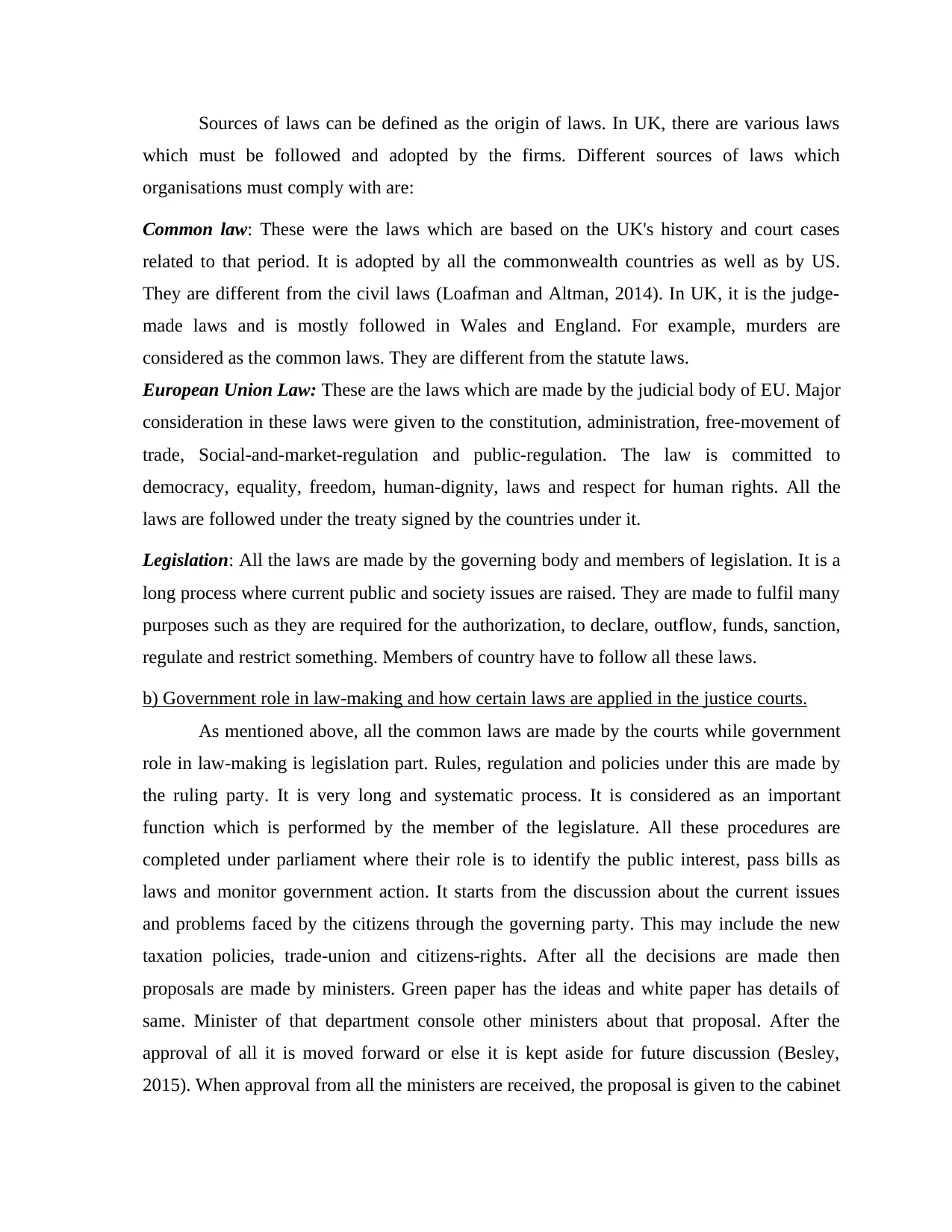
Sources of laws can be defined as the origin of laws. In UK, there are various laws
which must be followed and adopted by the firms. Different sources of laws which
organisations must comply with are:
Common law: These were the laws which are based on the UK's history and court cases
related to that period. It is adopted by all the commonwealth countries as well as by US.
They are different from the civil laws (Loafman and Altman, 2014). In UK, it is the judge-
made laws and is mostly followed in Wales and England. For example, murders are
considered as the common laws. They are different from the statute laws.
European Union Law: These are the laws which are made by the judicial body of EU. Major
consideration in these laws were given to the constitution, administration, free-movement of
trade, Social-and-market-regulation and public-regulation. The law is committed to
democracy, equality, freedom, human-dignity, laws and respect for human rights. All the
laws are followed under the treaty signed by the countries under it.
Legislation: All the laws are made by the governing body and members of legislation. It is a
long process where current public and society issues are raised. They are made to fulfil many
purposes such as they are required for the authorization, to declare, outflow, funds, sanction,
regulate and restrict something. Members of country have to follow all these laws.
b) Government role in law-making and how certain laws are applied in the justice courts.
As mentioned above, all the common laws are made by the courts while government
role in law-making is legislation part. Rules, regulation and policies under this are made by
the ruling party. It is very long and systematic process. It is considered as an important
function which is performed by the member of the legislature. All these procedures are
completed under parliament where their role is to identify the public interest, pass bills as
laws and monitor government action. It starts from the discussion about the current issues
and problems faced by the citizens through the governing party. This may include the new
taxation policies, trade-union and citizens-rights. After all the decisions are made then
proposals are made by ministers. Green paper has the ideas and white paper has details of
same. Minister of that department console other ministers about that proposal. After the
approval of all it is moved forward or else it is kept aside for future discussion (Besley,
2015). When approval from all the ministers are received, the proposal is given to the cabinet
which must be followed and adopted by the firms. Different sources of laws which
organisations must comply with are:
Common law: These were the laws which are based on the UK's history and court cases
related to that period. It is adopted by all the commonwealth countries as well as by US.
They are different from the civil laws (Loafman and Altman, 2014). In UK, it is the judge-
made laws and is mostly followed in Wales and England. For example, murders are
considered as the common laws. They are different from the statute laws.
European Union Law: These are the laws which are made by the judicial body of EU. Major
consideration in these laws were given to the constitution, administration, free-movement of
trade, Social-and-market-regulation and public-regulation. The law is committed to
democracy, equality, freedom, human-dignity, laws and respect for human rights. All the
laws are followed under the treaty signed by the countries under it.
Legislation: All the laws are made by the governing body and members of legislation. It is a
long process where current public and society issues are raised. They are made to fulfil many
purposes such as they are required for the authorization, to declare, outflow, funds, sanction,
regulate and restrict something. Members of country have to follow all these laws.
b) Government role in law-making and how certain laws are applied in the justice courts.
As mentioned above, all the common laws are made by the courts while government
role in law-making is legislation part. Rules, regulation and policies under this are made by
the ruling party. It is very long and systematic process. It is considered as an important
function which is performed by the member of the legislature. All these procedures are
completed under parliament where their role is to identify the public interest, pass bills as
laws and monitor government action. It starts from the discussion about the current issues
and problems faced by the citizens through the governing party. This may include the new
taxation policies, trade-union and citizens-rights. After all the decisions are made then
proposals are made by ministers. Green paper has the ideas and white paper has details of
same. Minister of that department console other ministers about that proposal. After the
approval of all it is moved forward or else it is kept aside for future discussion (Besley,
2015). When approval from all the ministers are received, the proposal is given to the cabinet
Paraphrase This Document
Need a fresh take? Get an instant paraphrase of this document with our AI Paraphraser
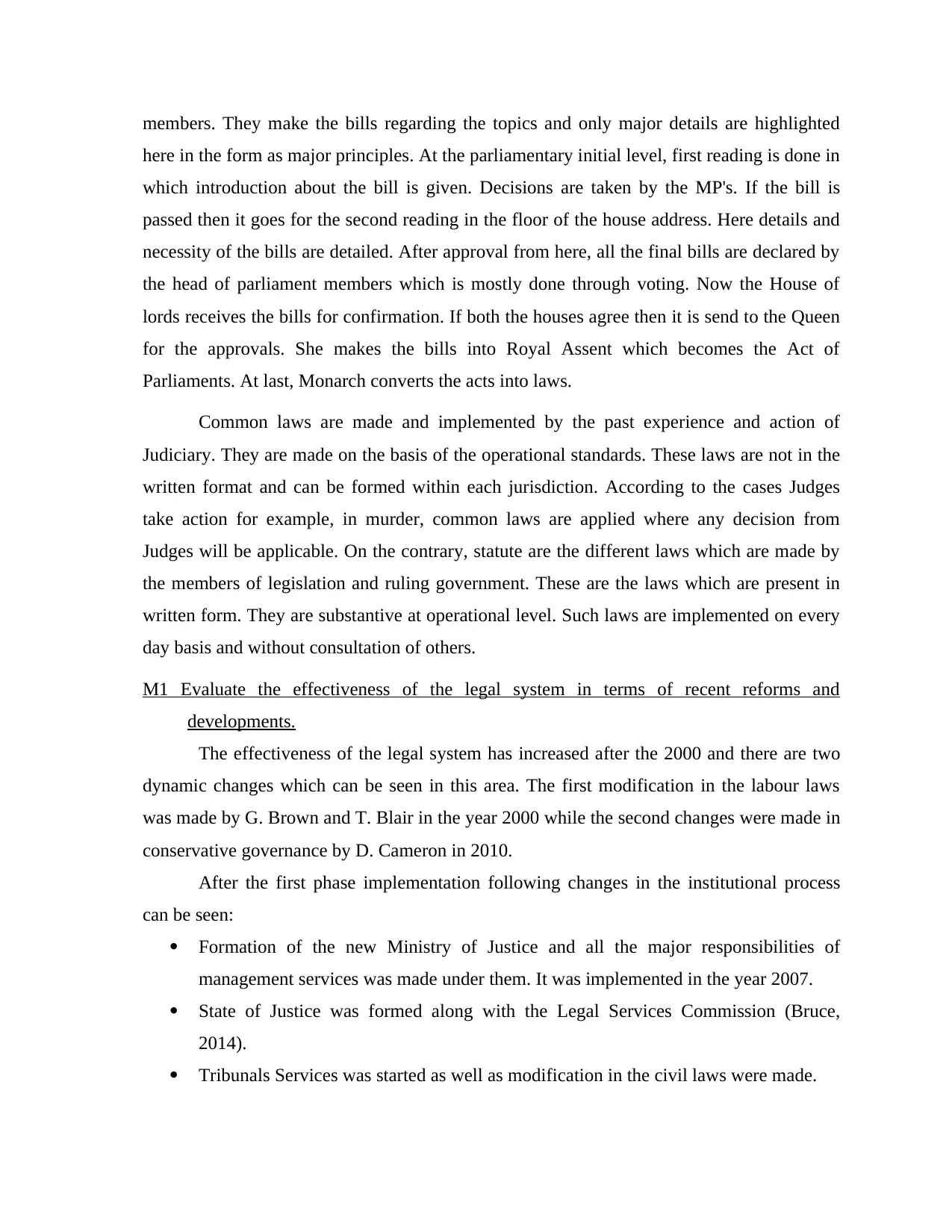
members. They make the bills regarding the topics and only major details are highlighted
here in the form as major principles. At the parliamentary initial level, first reading is done in
which introduction about the bill is given. Decisions are taken by the MP's. If the bill is
passed then it goes for the second reading in the floor of the house address. Here details and
necessity of the bills are detailed. After approval from here, all the final bills are declared by
the head of parliament members which is mostly done through voting. Now the House of
lords receives the bills for confirmation. If both the houses agree then it is send to the Queen
for the approvals. She makes the bills into Royal Assent which becomes the Act of
Parliaments. At last, Monarch converts the acts into laws.
Common laws are made and implemented by the past experience and action of
Judiciary. They are made on the basis of the operational standards. These laws are not in the
written format and can be formed within each jurisdiction. According to the cases Judges
take action for example, in murder, common laws are applied where any decision from
Judges will be applicable. On the contrary, statute are the different laws which are made by
the members of legislation and ruling government. These are the laws which are present in
written form. They are substantive at operational level. Such laws are implemented on every
day basis and without consultation of others.
M1 Evaluate the effectiveness of the legal system in terms of recent reforms and
developments.
The effectiveness of the legal system has increased after the 2000 and there are two
dynamic changes which can be seen in this area. The first modification in the labour laws
was made by G. Brown and T. Blair in the year 2000 while the second changes were made in
conservative governance by D. Cameron in 2010.
After the first phase implementation following changes in the institutional process
can be seen:
Formation of the new Ministry of Justice and all the major responsibilities of
management services was made under them. It was implemented in the year 2007.
State of Justice was formed along with the Legal Services Commission (Bruce,
2014).
Tribunals Services was started as well as modification in the civil laws were made.
here in the form as major principles. At the parliamentary initial level, first reading is done in
which introduction about the bill is given. Decisions are taken by the MP's. If the bill is
passed then it goes for the second reading in the floor of the house address. Here details and
necessity of the bills are detailed. After approval from here, all the final bills are declared by
the head of parliament members which is mostly done through voting. Now the House of
lords receives the bills for confirmation. If both the houses agree then it is send to the Queen
for the approvals. She makes the bills into Royal Assent which becomes the Act of
Parliaments. At last, Monarch converts the acts into laws.
Common laws are made and implemented by the past experience and action of
Judiciary. They are made on the basis of the operational standards. These laws are not in the
written format and can be formed within each jurisdiction. According to the cases Judges
take action for example, in murder, common laws are applied where any decision from
Judges will be applicable. On the contrary, statute are the different laws which are made by
the members of legislation and ruling government. These are the laws which are present in
written form. They are substantive at operational level. Such laws are implemented on every
day basis and without consultation of others.
M1 Evaluate the effectiveness of the legal system in terms of recent reforms and
developments.
The effectiveness of the legal system has increased after the 2000 and there are two
dynamic changes which can be seen in this area. The first modification in the labour laws
was made by G. Brown and T. Blair in the year 2000 while the second changes were made in
conservative governance by D. Cameron in 2010.
After the first phase implementation following changes in the institutional process
can be seen:
Formation of the new Ministry of Justice and all the major responsibilities of
management services was made under them. It was implemented in the year 2007.
State of Justice was formed along with the Legal Services Commission (Bruce,
2014).
Tribunals Services was started as well as modification in the civil laws were made.
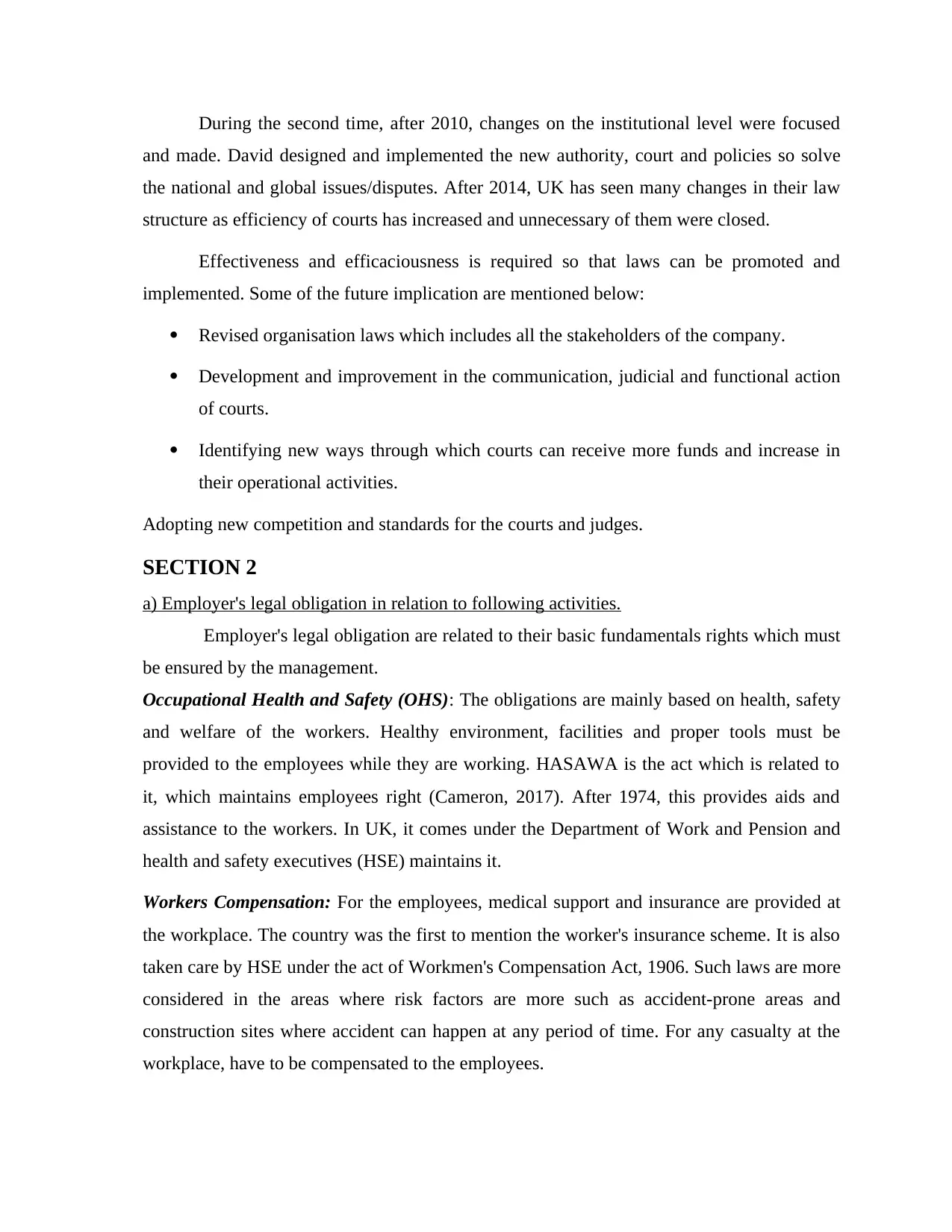
During the second time, after 2010, changes on the institutional level were focused
and made. David designed and implemented the new authority, court and policies so solve
the national and global issues/disputes. After 2014, UK has seen many changes in their law
structure as efficiency of courts has increased and unnecessary of them were closed.
Effectiveness and efficaciousness is required so that laws can be promoted and
implemented. Some of the future implication are mentioned below:
Revised organisation laws which includes all the stakeholders of the company.
Development and improvement in the communication, judicial and functional action
of courts.
Identifying new ways through which courts can receive more funds and increase in
their operational activities.
Adopting new competition and standards for the courts and judges.
SECTION 2
a) Employer's legal obligation in relation to following activities.
Employer's legal obligation are related to their basic fundamentals rights which must
be ensured by the management.
Occupational Health and Safety (OHS): The obligations are mainly based on health, safety
and welfare of the workers. Healthy environment, facilities and proper tools must be
provided to the employees while they are working. HASAWA is the act which is related to
it, which maintains employees right (Cameron, 2017). After 1974, this provides aids and
assistance to the workers. In UK, it comes under the Department of Work and Pension and
health and safety executives (HSE) maintains it.
Workers Compensation: For the employees, medical support and insurance are provided at
the workplace. The country was the first to mention the worker's insurance scheme. It is also
taken care by HSE under the act of Workmen's Compensation Act, 1906. Such laws are more
considered in the areas where risk factors are more such as accident-prone areas and
construction sites where accident can happen at any period of time. For any casualty at the
workplace, have to be compensated to the employees.
and made. David designed and implemented the new authority, court and policies so solve
the national and global issues/disputes. After 2014, UK has seen many changes in their law
structure as efficiency of courts has increased and unnecessary of them were closed.
Effectiveness and efficaciousness is required so that laws can be promoted and
implemented. Some of the future implication are mentioned below:
Revised organisation laws which includes all the stakeholders of the company.
Development and improvement in the communication, judicial and functional action
of courts.
Identifying new ways through which courts can receive more funds and increase in
their operational activities.
Adopting new competition and standards for the courts and judges.
SECTION 2
a) Employer's legal obligation in relation to following activities.
Employer's legal obligation are related to their basic fundamentals rights which must
be ensured by the management.
Occupational Health and Safety (OHS): The obligations are mainly based on health, safety
and welfare of the workers. Healthy environment, facilities and proper tools must be
provided to the employees while they are working. HASAWA is the act which is related to
it, which maintains employees right (Cameron, 2017). After 1974, this provides aids and
assistance to the workers. In UK, it comes under the Department of Work and Pension and
health and safety executives (HSE) maintains it.
Workers Compensation: For the employees, medical support and insurance are provided at
the workplace. The country was the first to mention the worker's insurance scheme. It is also
taken care by HSE under the act of Workmen's Compensation Act, 1906. Such laws are more
considered in the areas where risk factors are more such as accident-prone areas and
construction sites where accident can happen at any period of time. For any casualty at the
workplace, have to be compensated to the employees.
⊘ This is a preview!⊘
Do you want full access?
Subscribe today to unlock all pages.

Trusted by 1+ million students worldwide
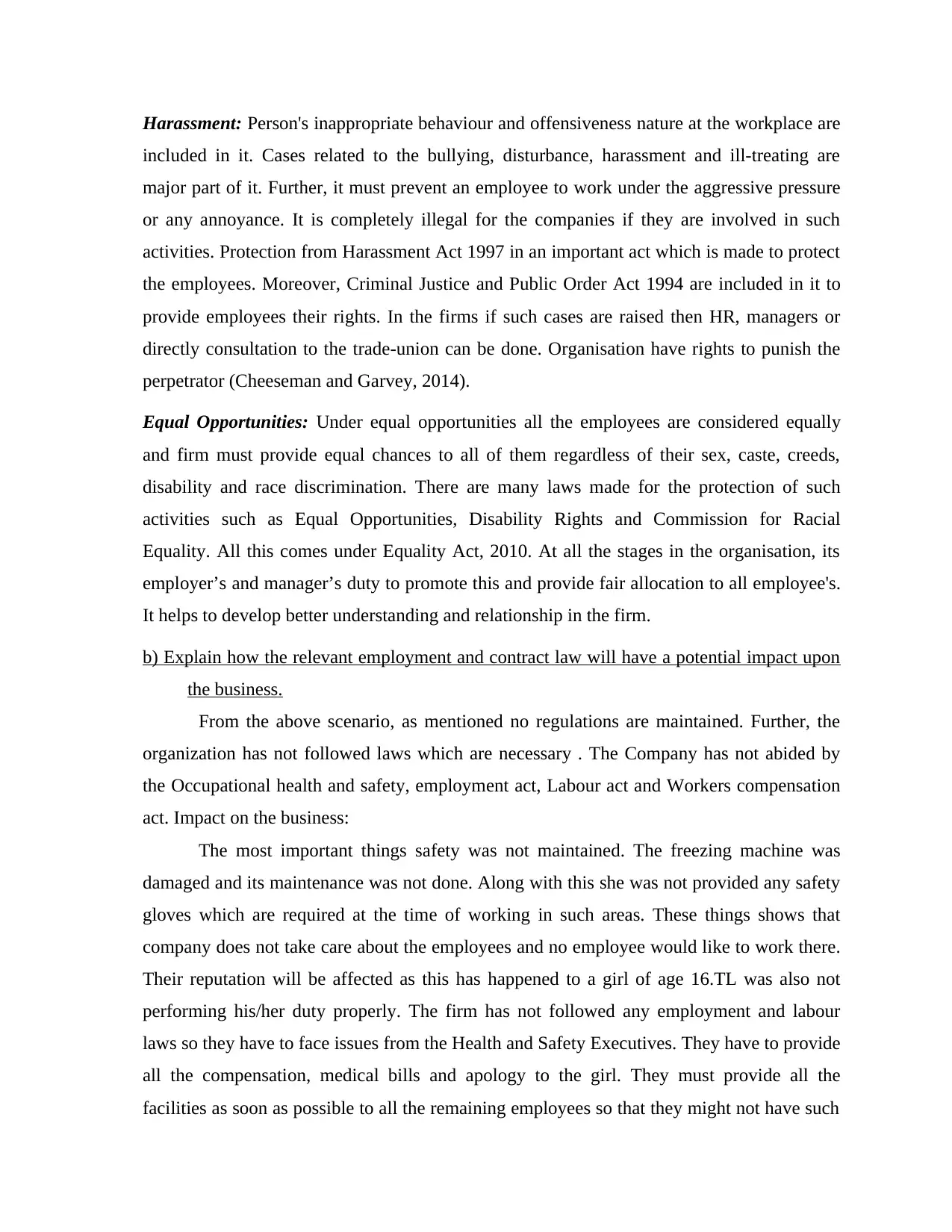
Harassment: Person's inappropriate behaviour and offensiveness nature at the workplace are
included in it. Cases related to the bullying, disturbance, harassment and ill-treating are
major part of it. Further, it must prevent an employee to work under the aggressive pressure
or any annoyance. It is completely illegal for the companies if they are involved in such
activities. Protection from Harassment Act 1997 in an important act which is made to protect
the employees. Moreover, Criminal Justice and Public Order Act 1994 are included in it to
provide employees their rights. In the firms if such cases are raised then HR, managers or
directly consultation to the trade-union can be done. Organisation have rights to punish the
perpetrator (Cheeseman and Garvey, 2014).
Equal Opportunities: Under equal opportunities all the employees are considered equally
and firm must provide equal chances to all of them regardless of their sex, caste, creeds,
disability and race discrimination. There are many laws made for the protection of such
activities such as Equal Opportunities, Disability Rights and Commission for Racial
Equality. All this comes under Equality Act, 2010. At all the stages in the organisation, its
employer’s and manager’s duty to promote this and provide fair allocation to all employee's.
It helps to develop better understanding and relationship in the firm.
b) Explain how the relevant employment and contract law will have a potential impact upon
the business.
From the above scenario, as mentioned no regulations are maintained. Further, the
organization has not followed laws which are necessary . The Company has not abided by
the Occupational health and safety, employment act, Labour act and Workers compensation
act. Impact on the business:
The most important things safety was not maintained. The freezing machine was
damaged and its maintenance was not done. Along with this she was not provided any safety
gloves which are required at the time of working in such areas. These things shows that
company does not take care about the employees and no employee would like to work there.
Their reputation will be affected as this has happened to a girl of age 16.TL was also not
performing his/her duty properly. The firm has not followed any employment and labour
laws so they have to face issues from the Health and Safety Executives. They have to provide
all the compensation, medical bills and apology to the girl. They must provide all the
facilities as soon as possible to all the remaining employees so that they might not have such
included in it. Cases related to the bullying, disturbance, harassment and ill-treating are
major part of it. Further, it must prevent an employee to work under the aggressive pressure
or any annoyance. It is completely illegal for the companies if they are involved in such
activities. Protection from Harassment Act 1997 in an important act which is made to protect
the employees. Moreover, Criminal Justice and Public Order Act 1994 are included in it to
provide employees their rights. In the firms if such cases are raised then HR, managers or
directly consultation to the trade-union can be done. Organisation have rights to punish the
perpetrator (Cheeseman and Garvey, 2014).
Equal Opportunities: Under equal opportunities all the employees are considered equally
and firm must provide equal chances to all of them regardless of their sex, caste, creeds,
disability and race discrimination. There are many laws made for the protection of such
activities such as Equal Opportunities, Disability Rights and Commission for Racial
Equality. All this comes under Equality Act, 2010. At all the stages in the organisation, its
employer’s and manager’s duty to promote this and provide fair allocation to all employee's.
It helps to develop better understanding and relationship in the firm.
b) Explain how the relevant employment and contract law will have a potential impact upon
the business.
From the above scenario, as mentioned no regulations are maintained. Further, the
organization has not followed laws which are necessary . The Company has not abided by
the Occupational health and safety, employment act, Labour act and Workers compensation
act. Impact on the business:
The most important things safety was not maintained. The freezing machine was
damaged and its maintenance was not done. Along with this she was not provided any safety
gloves which are required at the time of working in such areas. These things shows that
company does not take care about the employees and no employee would like to work there.
Their reputation will be affected as this has happened to a girl of age 16.TL was also not
performing his/her duty properly. The firm has not followed any employment and labour
laws so they have to face issues from the Health and Safety Executives. They have to provide
all the compensation, medical bills and apology to the girl. They must provide all the
facilities as soon as possible to all the remaining employees so that they might not have such
Paraphrase This Document
Need a fresh take? Get an instant paraphrase of this document with our AI Paraphraser
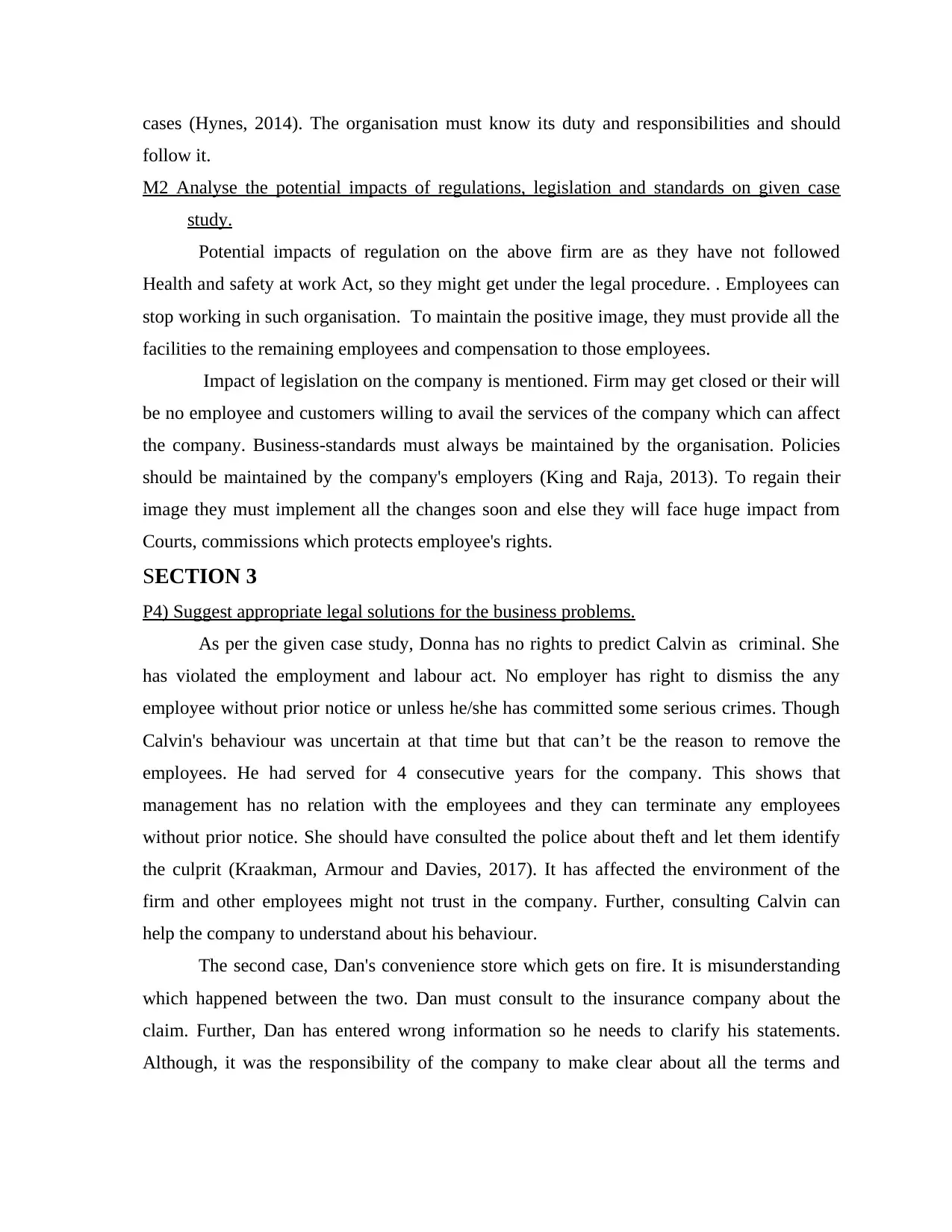
cases (Hynes, 2014). The organisation must know its duty and responsibilities and should
follow it.
M2 Analyse the potential impacts of regulations, legislation and standards on given case
study.
Potential impacts of regulation on the above firm are as they have not followed
Health and safety at work Act, so they might get under the legal procedure. . Employees can
stop working in such organisation. To maintain the positive image, they must provide all the
facilities to the remaining employees and compensation to those employees.
Impact of legislation on the company is mentioned. Firm may get closed or their will
be no employee and customers willing to avail the services of the company which can affect
the company. Business-standards must always be maintained by the organisation. Policies
should be maintained by the company's employers (King and Raja, 2013). To regain their
image they must implement all the changes soon and else they will face huge impact from
Courts, commissions which protects employee's rights.
SECTION 3
P4) Suggest appropriate legal solutions for the business problems.
As per the given case study, Donna has no rights to predict Calvin as criminal. She
has violated the employment and labour act. No employer has right to dismiss the any
employee without prior notice or unless he/she has committed some serious crimes. Though
Calvin's behaviour was uncertain at that time but that can’t be the reason to remove the
employees. He had served for 4 consecutive years for the company. This shows that
management has no relation with the employees and they can terminate any employees
without prior notice. She should have consulted the police about theft and let them identify
the culprit (Kraakman, Armour and Davies, 2017). It has affected the environment of the
firm and other employees might not trust in the company. Further, consulting Calvin can
help the company to understand about his behaviour.
The second case, Dan's convenience store which gets on fire. It is misunderstanding
which happened between the two. Dan must consult to the insurance company about the
claim. Further, Dan has entered wrong information so he needs to clarify his statements.
Although, it was the responsibility of the company to make clear about all the terms and
follow it.
M2 Analyse the potential impacts of regulations, legislation and standards on given case
study.
Potential impacts of regulation on the above firm are as they have not followed
Health and safety at work Act, so they might get under the legal procedure. . Employees can
stop working in such organisation. To maintain the positive image, they must provide all the
facilities to the remaining employees and compensation to those employees.
Impact of legislation on the company is mentioned. Firm may get closed or their will
be no employee and customers willing to avail the services of the company which can affect
the company. Business-standards must always be maintained by the organisation. Policies
should be maintained by the company's employers (King and Raja, 2013). To regain their
image they must implement all the changes soon and else they will face huge impact from
Courts, commissions which protects employee's rights.
SECTION 3
P4) Suggest appropriate legal solutions for the business problems.
As per the given case study, Donna has no rights to predict Calvin as criminal. She
has violated the employment and labour act. No employer has right to dismiss the any
employee without prior notice or unless he/she has committed some serious crimes. Though
Calvin's behaviour was uncertain at that time but that can’t be the reason to remove the
employees. He had served for 4 consecutive years for the company. This shows that
management has no relation with the employees and they can terminate any employees
without prior notice. She should have consulted the police about theft and let them identify
the culprit (Kraakman, Armour and Davies, 2017). It has affected the environment of the
firm and other employees might not trust in the company. Further, consulting Calvin can
help the company to understand about his behaviour.
The second case, Dan's convenience store which gets on fire. It is misunderstanding
which happened between the two. Dan must consult to the insurance company about the
claim. Further, Dan has entered wrong information so he needs to clarify his statements.
Although, it was the responsibility of the company to make clear about all the terms and
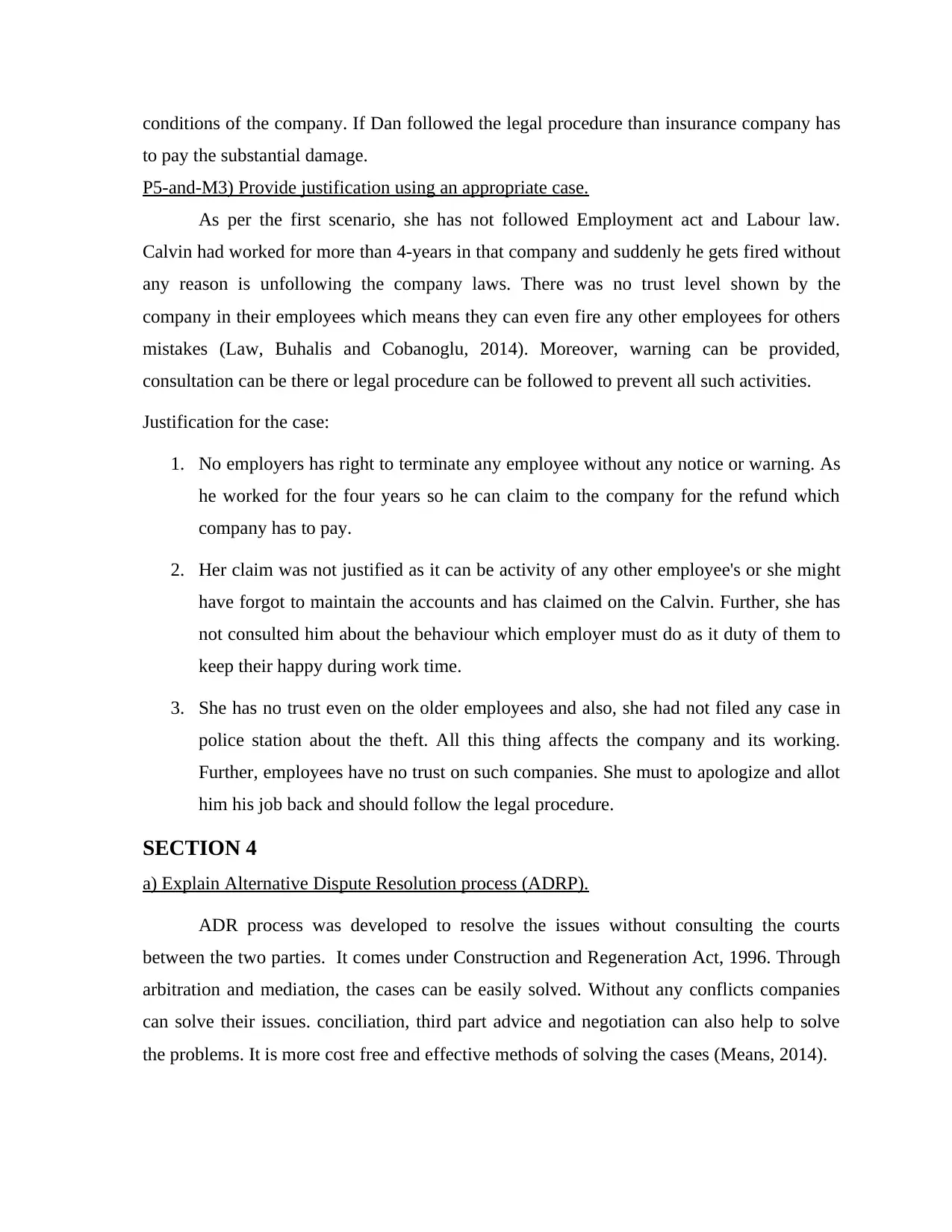
conditions of the company. If Dan followed the legal procedure than insurance company has
to pay the substantial damage.
P5-and-M3) Provide justification using an appropriate case.
As per the first scenario, she has not followed Employment act and Labour law.
Calvin had worked for more than 4-years in that company and suddenly he gets fired without
any reason is unfollowing the company laws. There was no trust level shown by the
company in their employees which means they can even fire any other employees for others
mistakes (Law, Buhalis and Cobanoglu, 2014). Moreover, warning can be provided,
consultation can be there or legal procedure can be followed to prevent all such activities.
Justification for the case:
1. No employers has right to terminate any employee without any notice or warning. As
he worked for the four years so he can claim to the company for the refund which
company has to pay.
2. Her claim was not justified as it can be activity of any other employee's or she might
have forgot to maintain the accounts and has claimed on the Calvin. Further, she has
not consulted him about the behaviour which employer must do as it duty of them to
keep their happy during work time.
3. She has no trust even on the older employees and also, she had not filed any case in
police station about the theft. All this thing affects the company and its working.
Further, employees have no trust on such companies. She must to apologize and allot
him his job back and should follow the legal procedure.
SECTION 4
a) Explain Alternative Dispute Resolution process (ADRP).
ADR process was developed to resolve the issues without consulting the courts
between the two parties. It comes under Construction and Regeneration Act, 1996. Through
arbitration and mediation, the cases can be easily solved. Without any conflicts companies
can solve their issues. conciliation, third part advice and negotiation can also help to solve
the problems. It is more cost free and effective methods of solving the cases (Means, 2014).
to pay the substantial damage.
P5-and-M3) Provide justification using an appropriate case.
As per the first scenario, she has not followed Employment act and Labour law.
Calvin had worked for more than 4-years in that company and suddenly he gets fired without
any reason is unfollowing the company laws. There was no trust level shown by the
company in their employees which means they can even fire any other employees for others
mistakes (Law, Buhalis and Cobanoglu, 2014). Moreover, warning can be provided,
consultation can be there or legal procedure can be followed to prevent all such activities.
Justification for the case:
1. No employers has right to terminate any employee without any notice or warning. As
he worked for the four years so he can claim to the company for the refund which
company has to pay.
2. Her claim was not justified as it can be activity of any other employee's or she might
have forgot to maintain the accounts and has claimed on the Calvin. Further, she has
not consulted him about the behaviour which employer must do as it duty of them to
keep their happy during work time.
3. She has no trust even on the older employees and also, she had not filed any case in
police station about the theft. All this thing affects the company and its working.
Further, employees have no trust on such companies. She must to apologize and allot
him his job back and should follow the legal procedure.
SECTION 4
a) Explain Alternative Dispute Resolution process (ADRP).
ADR process was developed to resolve the issues without consulting the courts
between the two parties. It comes under Construction and Regeneration Act, 1996. Through
arbitration and mediation, the cases can be easily solved. Without any conflicts companies
can solve their issues. conciliation, third part advice and negotiation can also help to solve
the problems. It is more cost free and effective methods of solving the cases (Means, 2014).
⊘ This is a preview!⊘
Do you want full access?
Subscribe today to unlock all pages.

Trusted by 1+ million students worldwide
1 out of 15
Related Documents
Your All-in-One AI-Powered Toolkit for Academic Success.
+13062052269
info@desklib.com
Available 24*7 on WhatsApp / Email
![[object Object]](/_next/static/media/star-bottom.7253800d.svg)
Unlock your academic potential
Copyright © 2020–2026 A2Z Services. All Rights Reserved. Developed and managed by ZUCOL.





